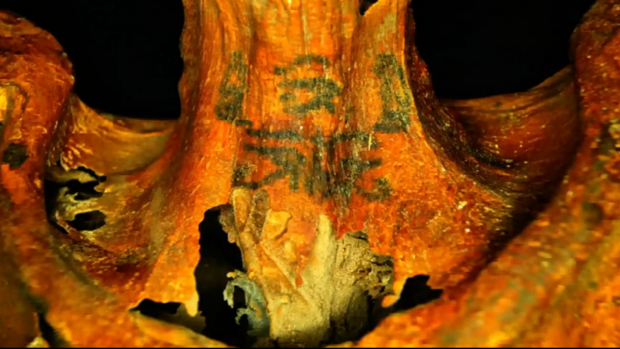The use of picturing software and infrared scanners allowed experts to discover more than 30 tattoos on a 3-millennium-old mummy.
Quebec investigators are honoring the finding of an intricate assemblage of tattoos discovered on a mummified body of a woman who existed more than 3,000 years ago.
The symbols are the first found on a mummy from dynastic Egypt that displays real objects – in this case, lotus blossoms on the mummy’s hips and cows located on her arm.
Cédric Gobeil has been leading a squad of specialists in Egypt since 2013. They reported the finding April of this year.
When Gobeil gazed at the darken spots located on the mummy, he was astonished by what he saw. It was so striking – you do not search for something like that, and once you see it you can not even imagine.
According to Gobeil, about a dozen other mummies have been discovered with tattoos of simple figures, commonly about the belly, which was believed to offer magical protection throughout the duration of pregnancy, CBC News reported.
None of those more common tattoos show up on this mummy. More than 30 pictures of animals appear on the arms and torso. The mummy’s legs and head are missing, yet the investigators have located tattoos on these specific areas on the body.
The specialists thought the mummy of the woman around the age of 24-35 years old might have been a priestess of the Egyptian goddess Hathor. Although Hathor is the goddess of several things, her relation to the dead is what has linked her with this mummy.
Almost overlooked
The black symbols located on the mummy’s body were almost unnoticed; thought to be matter from the mummification procedure. Egyptologist and archaeologist Cédric Gobeil, who is from Quebec, has been leading an archaeological mission in Egypt since the year of 2013.
He stated that with the modern picturing software his squad was capable of extending the mummy’s skin, which is how they were able to see the striking tattoos. As they examined the body with a fancy camera, they discovered tattoos which were not visible to the naked eye.
Some fragments of the body were so dark and covered within conserving fluid it’s impossible to see the skin. Using this camera allows researchers to see through the layer of the skin as it used to be.
Gobeil also stated that his finding turns back the thought Egyptologists once had about the priestesses being painted with the imagery of animals instead of being tattooed. The tattoos discovered on this mummy are unique for the reason that there are a lot of snakes, and some other symbols and animals which, when taken altogether, link this woman to the goddess Hathor.
Within the tombs, there are walls with pictures of women covered in markings that correspond to those this mummy had.
